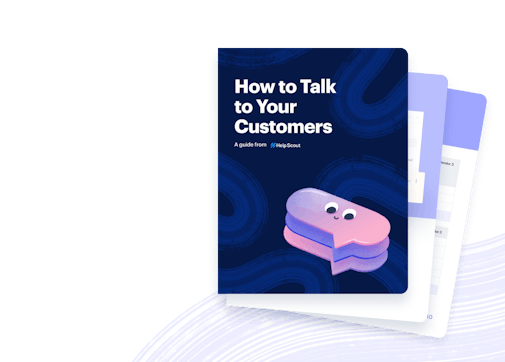Repeatable phrases are helpful for bringing consistency to customer service. After all, providing great customer service means knowing exactly what to say and the best way to say it.
But communication is hard, and it’s even harder when you’re trying to make the mundane memorable. After all, most support conversations are pretty standard: “I have a problem,” and “Let me fix that problem for you.”
Using the right customer service phrases in even the most straightforward support interactions can transform a good customer experience into a great one. On the other hand, using the wrong phrases can make an otherwise exceptional support experience feel impersonal.
12 excellent customer service phrases
In customer support, improving your ability to convey information in a concise, friendly style will yield better results than anything else. Nothing delivers quite like consistently delightful communication.
Use these 12 customer service phrases to improve almost all of your support interactions.
1. “Happy to help!”
Not every customer will tell you that they are walking away unhappy — in fact, few will. So it's important to make sure that the customer leaves satisfied. Ending your emails without a closing message can be risky as it’s not inviting the customer to share further issues — issues you sincerely want to hear about.
For an outspoken person like myself, it was initially hard for me to understand why some people might just slink away without bringing up additional problems. Maybe they don’t want to be a burden, or maybe they think you don’t care. Whatever the reason, you need to let them know that you’d be happy to hear them out.
That’s why I end 99% of my messages with, “Let me know if there’s anything else I can do for you. I’m happy to help.” It’s my way of saying that it would be my pleasure to assist with any lingering concerns that may have cropped up or answer any questions they may feel are silly. There are no silly questions in support.
2. “I understand how (blank) that must be.”
When you say, "I understand how (blank) that must be," the word you use to fill the blank will greatly affect the tone of your message — one that is obviously being used with an upset customer.
Here’s a quick personal story: I ordered a birthday gift for a friend of mine from a hobby site. Usually, I couldn’t care less about whether something ships on time; I’m patient and forgetful, the perfect customer.
However, this order was botched beyond belief. I was charged for and sent two orders instead of one, it was sent to my house when I specified my friend’s address, and as the cherry on top, it was sent late. The support person’s response when I emailed in: “I understand how annoying that must be.”
I’m sorry, I was beyond annoyed. I was upset, and she should have known to empathize with how upsetting that must be for me. Upset customers are driven by emotion — not logic — as I was in that instance. I felt like I had let my friend down, and it made me frustrated in a situation I otherwise would have brushed off.
Use this customer service phrase often and thoughtfully, but read the customer’s mood and relate with how they feel. Great support is defined by genuine empathy.
3. “As much as I’d love to help ...”
There comes a time when the only answer is “no.” Some requests just aren’t feasible. While some hand-holding is fine, it can do more harm than good if it leads to stringing a customer along.
But imagine answering a genuinely enthusiastic request with a blunt “no.” That stings. Stay firm but kind by letting them know you’d like to help, but it’s just not possible in this situation.
One of our readers asked about using positive language when a customer makes unscalable support requests. Our suggestion:
As much as I'd love to help, your request is beyond what we're able to do for customers.
Follow that statement by pointing to a couple of helpful resources.
It’s never fun to say, "We can’t do that," but just as you have to bite the bullet and say “no” to feature requests, you sometimes have to turn down a service request. But you can at least do it nicely.
4. “Great question! I’ll find that out for you!”
Not knowing the answer to a question is a difficult scenario for anyone to be in, especially if you are new. The biggest mistake to make is turning the situation into your situation: “I’m so sorry, I’m new!” or “Sorry, I’ve never been asked that before!”
Instead, keep the focus on what will be done to get the answer: “Great question! Let me check our documentation so I can get that answered for you.”
Never say “If I recall correctly” or any other variant of "maybe,” “perhaps,” or “I’m pretty sure.” Don’t guess for a customer. Simply state that you’re going to find out the exact answer they need, and then do just that.
The only customers who will mind the small delay to get the right answer are those who weren’t going to walk away happy in the first place.
Whenever you’re able to put the spotlight on what will be done rather than what’s happened, you’ve made a smart move.
5. "Nice to meet you!"
I can’t begin to count the number of times I’ve gotten in touch with a new company only to receive a robotic response from some person replying from their support@dontcare.com email address.
Let's take a look at how this might play out. Say a customer initiates an email conversation with you like this:
"Hey! Stephanie here. Found you through your blog. I'm liking what I'm seeing so far! I had a few questions about your product before I consider making the switch from our old solution. So for integrations..."
Too many companies beeline for the boring response: “Quinn, for integrations we offer...” Quinn certainly wants her answer, but it’s obvious from the language she is using that exchanging a few pleasantries would be welcome. For example:
"Hey Stephanie! It's great to meet you! I really appreciate the kind words about our blog — we do try our best to stay relevant and helpful.
I'm happy to answer any and all questions you have about the product. To begin with, our integrations..."
Using a friendly tone of voice goes a long way in creating real customer engagement. It never hurts to showcase that there are competent, friendly, and passionate people sitting at the other end of the screen.
6. “May I ask why that is?”
This is one to keep close as critics and complainers on the web are all too common. You’ll need a way to dig deeper into their criticism without stooping to the abrasive language they tend to use.
Consider if someone tweeted this about your company: “The way Company X handles (feature) is freaking ridiculous. It’s unbelievable.”
Even if the comment feels malicious, you might be curious as to what brought them to that conclusion. Approaching this situation with care is important because you don’t want to walk away as the bad guy.
This is where “May I ask why that is?” comes in handy. While it won’t pacify every vitriolic commenter, it always puts you in the right. Who can fault you for kindly asking for additional feedback?
7. “Thanks for bringing this to our attention!”
People who offer a detailed report of a bug they encountered are the unsung heroes of your product’s quality control. Most customers don’t speak up, so you should cherish those who do.
Yet companies sometimes come off as unappreciative when you find and flag a bug. At the very least, offer these customers your thanks by replying with a “Thanks so much for the heads up!” or “Hey, I really appreciate you taking the time to bring this to our attention!”
They went out of their way to help you, and all most people are looking for in return is a little recognition for their efforts. Show them you care.
8. “I completely understand why you’d want that.”
Most customers can name at least one “missing” feature that would improve their experience with your product, but you can’t acquiesce to every feature request without your product turning into a bloated, unusable mess.
You have to say “no.” But you can at least empathize and acknowledge that people use your product in many different ways. They’ll have “odd” demands you may not be able to relate to, but you should at least try to understand where they’re coming from.
You should not say, “No, we’re not building that.” It may be true, and it’s totally fair, but it comes across as uncaring. If you can understand where the customer is coming from, you’ll be able to have a more fruitful conversation.
Empathy always makes hearing the “no” sting a little less. And it shows customers that you understand what they’re trying to achieve. Who knows? Down the line you may build something that solves their problem in a way they hadn’t thought of.
9. “I’d love to understand more about ...”
When replying to a customer, you’re actually juggling three responsibilities: answering their question, replying in a timely manner, and teasing out the root cause (if one exists). The customer only cares about the first two. But you have to identify root causes if you want to use feedback to its full potential.
That’s why asking to “understand more” about a customer’s situation is a nice kickoff. You’re letting them know they have your ear and that they’re free to share more of their frustrations with or use cases for your product.
Steer clear of implying that this sort of feedback is unwelcome. You may innocently ask the customer, “Why would you want that?” But phrasing your question that way feels abrasive and uninviting.
10. “I've passed this on to our team”
Sharing feedback with a company can sometimes feel like shouting into a black hole. Assuring a customer that you have recorded their comment and passed it on to the right people helps them feel listened to and appreciated.
However, never tell customers that you’re passing on their request if it’s not true. If you know you’ll never make that change, be upfront with your customers and give them your best alternative options.
11. “I’ve read through the conversation so far.”
Often, support conversations need to be handled by more than one customer service team member due to a shift changeover or a question that requires special handling.
For the customer, those changes can be worrying. They anticipate having to repeat all of their previous conversation with a new person. Smooth that transfer process for them by explicitly confirming that you are up to speed on the situation and will help them move forward.
Never make the customer repeatedly explain their situation. Use internal notes and a deliberate handover process to make the transition as seamless as possible.
12. “Thank you for being our customer!”
Customer support teams are in a wonderful position to be able to actively thank customers for their business. When a problem has been resolved or a question answered, take a moment to appreciate the customer for choosing to work with you.
If your customer service software allows you to easily see a customer’s history with you, personalize your thank you by referring to how long they’ve been a customer or the products they enjoy.
A genuine thank you is rare, but it’s a very simple, positive way to build a stronger relationship with the people who really do pay the bills.
Finally, never thank your customer if they're not satisfied with the conversation so far. Focus on getting that resolution first; a thank you that comes too early can seem insincere to an upset customer.
8 customer service phrases to avoid
The customer service phrases you'll want to avoid usually involve fall into one of three categories:
They’re cliché. For some reason, we all have things we think we should say because they’ve been said so many times to us before, but at some point, they become trite.
They’re tone-deaf. They make it seem like you don’t understand the customer’s problem and you’re not really that interested in helping.
They’re not genuine. Customers want to feel like they matter to the company they're choosing to do business with.
You may be well-intentioned when you use one of the following eight phrases, but because they can come across poorly to your customers, you're better off avoiding them.
1. “Your call is important to us.”
Just like in other relationships, actions speak louder than words. You can say that your customers’ business is important to you, but if you aren’t doing anything to keep that business, they know you don’t mean it.
Many people feel that businesses only care about them to the point they can get money from them. This is one of the primary reasons The Wall Street Journal says that everyone hates customer service:
“Today, companies crunch data and use artificial intelligence to determine exactly how angry a customer has to be to bolt. Many are walking right up to that line.”
Platitudes about the importance of your call are simply in place to sound polite.
If you’re one of the companies that is consistently trying to make customer support better and truly do care about your customers’ business, show it — don’t just say it.
2. “Our apologies for any inconvenience this may cause.”
Somewhere in the history of customer service, it became mandatory to apologize for any inconvenience — or even the possibility of inconvenience. And because this phrase became so overused by companies who didn’t really seem to mean it, it became one of the most hated expressions.
Claire Littell, a member of the Support Driven community, says: “I specifically hate ‘I apologize for any inconvenience this may cause’ because it completely fails to acknowledge that there is an actual problem that is affecting you and causing trouble for you.”
“Of course this problem is inconvenient,” agrees Johnathan Lyman, another member of Support Driven. His solution: “Take ownership instead.”
Maybe this common phrase came from a genuine desire to minimize the problem and apologize at the same time. But instead of resorting to an overused, disingenuous expression, be specific and direct. Say exactly what you are apologizing for and what you’re doing to solve the issue.
3. “Thank you for the feedback.”
Most blog posts on dealing with customers will tell you to thank them for their feedback. But Sarah Hatter, Founder of CoSupport and ElevateCX, disagrees.
“‘Thank you for your feedback’ is by far my least favorite customer support platitude. It’s such an empty, copy-paste phrase that shows no real human touch, and it’s pervasive in the CX industry. Many of us use it to respond to customers on a daily basis and, often, we say it without taking any further action."
As an alternative, Sarah says to “try replacing customer feedback with customer insight to put a more positive, authentic spin to your support interactions. It’s such a simple tweak that dramatically changes the tone and intent of your message.”
4. “Unfortunately, I can’t do that for you.”
A few years ago, Apple’s training manual of “forbidden customer service words” was leaked to Gizmodo. Within the manual, Apple’s legal team suggests alternatives to common customer service phrases that might rub customers the wrong way or lead to a legal issue.
“Unfortunately” becomes “as it turns out”
“Bug” becomes “condition”
“Running hot” becomes “a bit warm”
Apple Geniuses are trained to take something that might sound negative (like a replacement part being out of stock) and turn it into something positive ("As it turns out, they can order that part for you! It will be here on Wednesday.").
Instead of focusing on what you can’t do for a customer, focus on what you can do.
No one likes to be told no. As Nicereply explains in their article on Experience Engineering, “experiencing rejection leads to an immediate 30% drop in reasoning skills and increases aggression. By saying 'no' you’re making frustrated customers more difficult to deal with.”
5. “Can you send a fax?”
Nobody wants to jump through hoops to accomplish a small task. So when customer service agents tell me to download and print a PDF, sign it, and then scan or even — the horror — fax it back to a different department, I feel my frustration is justified.
Even if you aren’t being directed to an ancient fax line to contact the right department, being shuffled around through other companies’ bureaucratic processes is infuriating. From being told to call a 1-800 number on Twitter to a brick-and-mortar cell phone store saying you need to call to cancel, unfortunately, it’s commonplace.
Microsoft found that most customers have used more than three different communication channels to get service. Instead of sending your customers back and forth between conversations and channels, make every effort to help customers on the channel through which they contacted you.
6. “I’m sorry you feel that way.”
Humans are pretty good at picking up on social cues. When someone apologizes and seems insincere, we can sense that. Because an apology is meant to repair a relationship, a bad apology can actually do more harm than no apology at all.
Beth Nelson from Support Driven shared her least favorite apology: “I’m sorry you feel that way.” Oof. We can all identify with the frustration of receiving this traditional non-apology. It doesn’t take ownership and it doesn’t admit fault.
It takes time to formulate a genuine apology that can heal your relationship with the customer, but it’s worth it. As Helps Scout’s Mathew Patterson says, “Acknowledgement of fault is a powerful act. It tells the customer: You are right. I see your perspective, and I understand it.”
By going beyond the typical non-apology, you can win back a customer who you might have otherwise lost.
7. “Can I help you with anything else today?”
At first glance, this might seem like a super helpful customer service phrase that you should definitely use. But if it gets pulled out at the wrong time, it can infuriate customers who don’t feel like they got any help in the first place.
“My personal pet peeve is ‘Can I help you with anything else today?’ when the person was unable to help me with the thing I first contacted them about,” says Brian Levine, another member of the Support Driven community.
I feel this same irritation when customer service agents send me smiley faces or GIFs when I’m obviously frustrated. Being able to read the room and react appropriately to a customer’s mood is important for a good customer service interaction.
8. “I’m sorry. I didn’t recognize that request.”
As chatbots are becoming more commonplace in customer service, it’s important to take into account how they are communicating. Even robots aren’t immune from dropping a frustrating phrase into a conversation.
Whether it’s by a voice-operated call center menu or a chatbot helper, customers hate being told that they aren’t asking their question quite right.
In a 2019 report, Forrester predicted that “human resistance against ineffective chatbots is on the way, and a groundswell of jaded customers will crowdsource tips for end runs around chatty chatbots.”
If you’re using chatbots for customer service, ensure that they are able to interact with human communication and that their automated responses are well thought out.
A better way to communicate
As you consider which phrases you should start and stop using, remember that the most important thing you can do is be authentic when interacting with customers.
No phrase is a set of magic words that will automatically improve your customer experience. However, understanding which phrases create warm feelings and which come across as impersonal is an important part of thoughtfully responding to customers.
Sarah Chambers, a customer service consultant and the founder of Supported Content, also contributed to this article.





